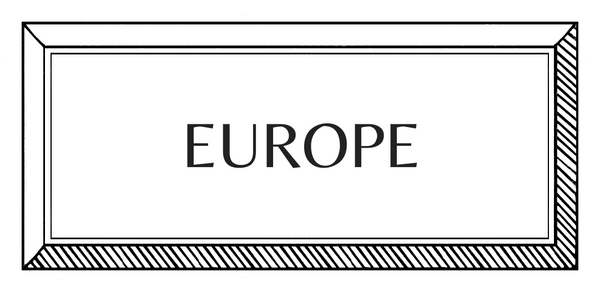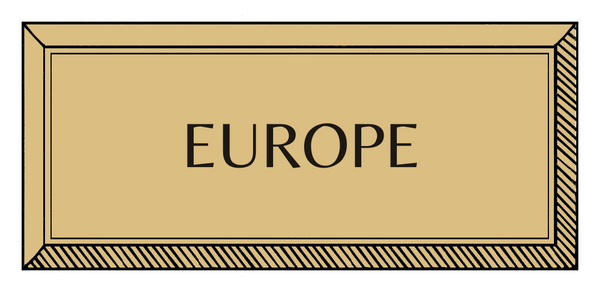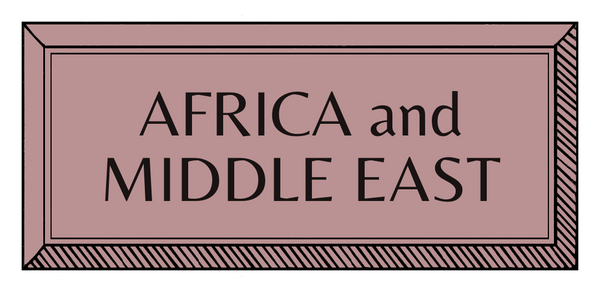CRAFT STORIES | ASIA | RUSSIA | TEXTILES
Kitmir: The Story of Russian Embroidery in Paris

Sketches of 20th-century Kitmir designs © Chanel Archives
Garments made by early 20th-century Russian emigres, for the former couture house Kitmir, are considered to be among the most beautiful pieces of modern fashion history, notably inspiring Coco Chanel. But the unlikely twists of fate that led to their creation are tragic, and surprising. Jamie Sharp explores the intriguing tale of Kitmir.
In history, sometimes it happens that a series of dominoes fall, creating circumstances previously unimaginable to those involved. For a group of blue-blooded Russians this was the case after the fated events of 1917, which led many of them to find themselves in a new reality much stranger than fiction.
Few could have imagined that Russia’s intelligentsia and aristocracy could be scattered across the globe with such violence, losing so much in so short a time period. Fleeing the war, Russians arrived in their thousands in the fashionable cities they once frequented as wealthy tourists, seeking refuge in Paris, London, and Rome. Escaping the revolution even sent some as far as Shanghai.
From this bloodshed and reversal of fate came the unlikely birth of the fashion house, Kitmir, which produced some of the finest garments of the 20th century. It’s hard to overstate how dramatically fortunes changed during this time period. Most aristocratic Russians, as well as many thousands of others, fled the revolution to Paris for the simple reason that they were already acquainted with the city; it was the natural destination outside of Russia when it came time to escape. They had long enjoyed its shopping, operas, parties and culture, with some Russians already owning apartments there. Grand Duke Paul Alexandrovitch, for example, had a spectacular Paris mansion and was well established in Parisian haute société.

Garments produced by Russian emigres are considered among the most beautiful pieces of modern fashion history © Chanel Archives
Russians had also loved the city for its freedoms. Tsarist Russia was a heavily censored state, with great scrutiny and protocol placed upon members of its society. So, to Paris they went, with the more fortunate relying on the kindness of well-placed friends to help them, while the less fortunate found work in the Renault car factory outside the city. Many of these new factory workers were intellectuals and well-regarded professionals; contemporary sources note you could tell which worker was Russian because they wore a suit and tie at the assembly line.
It has been reported that French workers hated their Russian colleagues because they would never strike, never complain, and always worked the hardest - they couldn’t afford not to. Many of the aristocratic men, having been born into extraordinary inherited wealth in an almost feudal imperial system, had no practical skills to support themselves in the real-world circumstances they now faced. Thus, those men had to turn to their wives who all largely possessed one common skill: embroidery and needlework. Often highly educated in a number of areas, it was de rigueur in Russia for aristocratic women to learn to sew from childhood.
What was once a recreational pastime for these women quickly became a vital lifeline. Due to this, a number of couture and fashion houses begun by the Russian nobility began to appear in Paris. The influx of Russian fashions across Europe saw women wearing styles a la Russe, such as furs and boyars. Parisian society was moved by the plight of the women who industriously sought to improve their situation.
One French magazine wrote: “There was a time when her mother and grandmother ordered their dresses from Worth and Poiret, but this young Russian woman has just escaped from the hell of the revolution and civil war! She has arrived in the capital of female elegance and knocked on the doors of a Maison de Haute Couture.”
Coco Chanel too was charmed by the well-educated and old fashioned emigres who had suddenly entered Paris haute société. During a holiday in Biarritz, Chanel met (and began an affair with) the handsome Dimitry Pavlovitch, Grand Duke of Russia and first cousin of Tzar Nicholas II. Tall, well mannered, and gentle, while silently carrying the deep sadness of the revolution, Dimitry instilled in Chanel a love of Russia that would last a lifetime. This affair resulted in Chanel’s ‘Slavic Period’, a time in which the couture house produced many Russian inspired garments.

Through Dimitry, Coco Chanel also become acquainted with his sister, the Grand Duchess Maria Pavlovna Romanovna, who had begun a fashion company called Kitmir, which specialized in creating extraordinary Russian embroideries.
Under Chanel’s direction, Kitmir began to create Slavic embroideries in spectacular and decadent designs, which are now remembered as some of the most intricate ever seen on Chanel’s garments. Inspired by her hugely successful work with Maria Pavlovna, Chanel even went on to create a perfume with Ernest Beaux, the exiled imperial perfumer of the Romanov family. Beaux had created a scent to commemorate the 300th anniversary of the Romanov Dynasty just a few years before the revolution, and was considered by many to be a genius. He was commissioned by Chanel to create a number of samples, of which she famously selected the one numbered 5, creating Chanel N*5.

Under Chanel’s direction, Kitmir began to create Slavic embroideries in spectacular and decadent designs © Chanel Archives
Other Russians outside the Imperial family turned to couture, among them Prince Felix Yusupov and his wife, Princess Irene, who established the house of Irfe - a combination of their two first names. Yusupov was an infamous dandy, though is most notable for his successful plot to kill the peasant mystic, Grigori Yefimovitch, also known as Rasputin. The deadly allure of its Princely owner’s past brought great success to the house, with boutiques opening across Europe.
Maria Pavlovna wrote of this time: “We had been torn out of our brilliant setting, we had been driven off the stage still dressed in our fantastic costumes. We had to take them off now, make ourselves other, more everyday clothes.”
While somewhat tragic, Maria’s words reflect a bracing acceptance of change. The garments made by Russian emigres, such as Maria Pavlovna, are now considered to be among the most beautiful and valuable pieces produced in modern fashion history. When looking at these objects of beauty it is startling to imagine the unlikely twists of history that had to take place for them to come into existence.

Left: Prince Felix Yuspov and Princess Irina Alexandrovna. Right: Grand Duchess Maria Pavlovna Romanovna © Chanel Archives.
Words by Jamie Sharp
Images from Chanel Archives and Kitmir: Chanel's Russian Embroideries


































